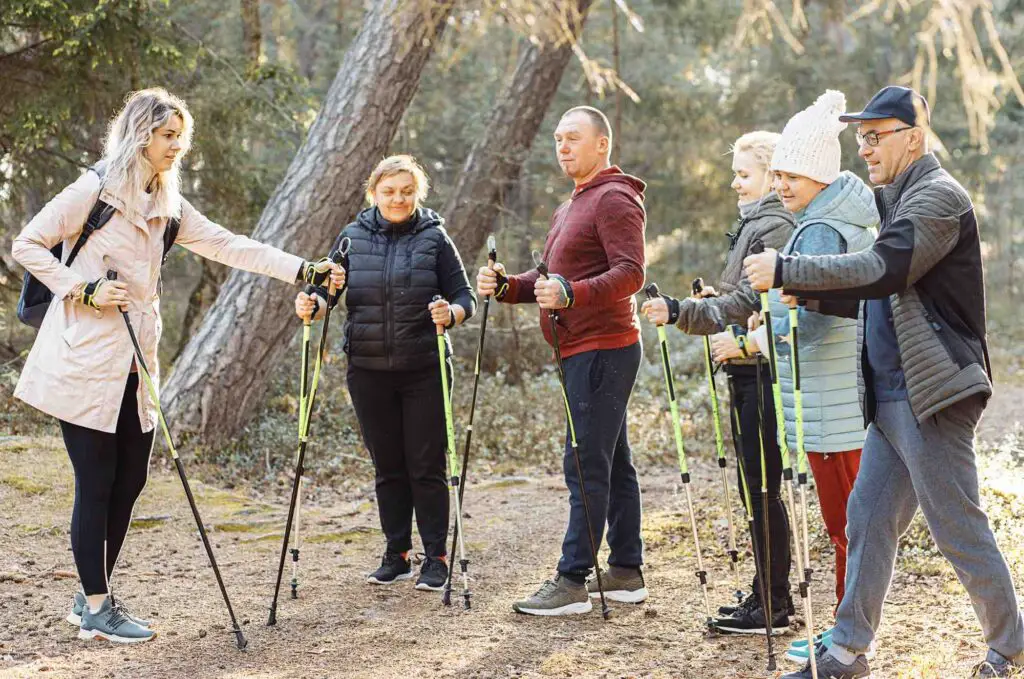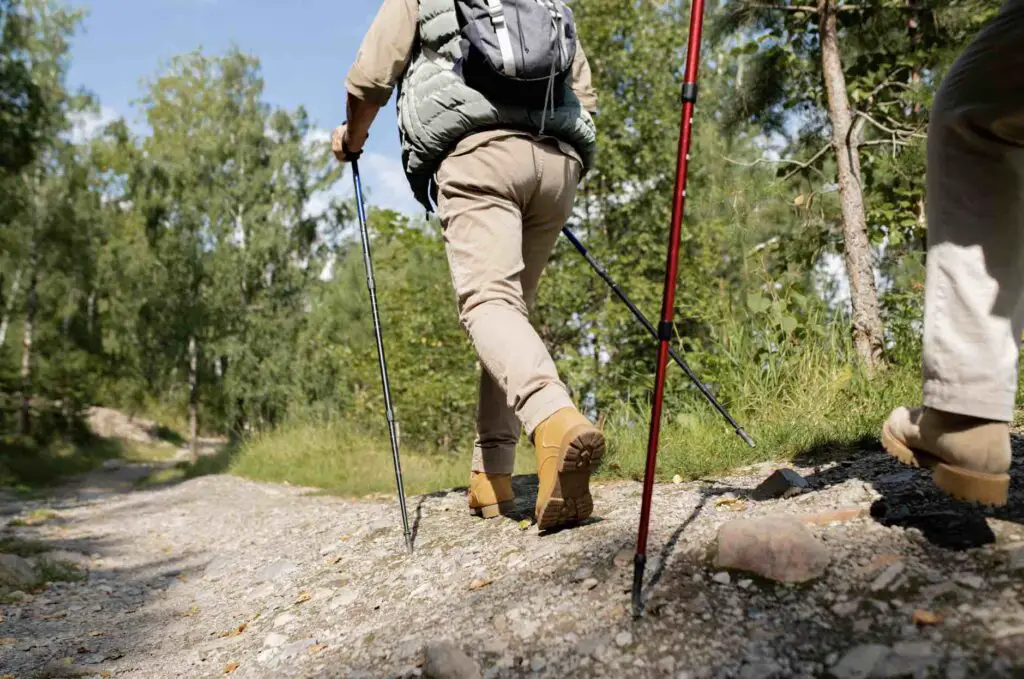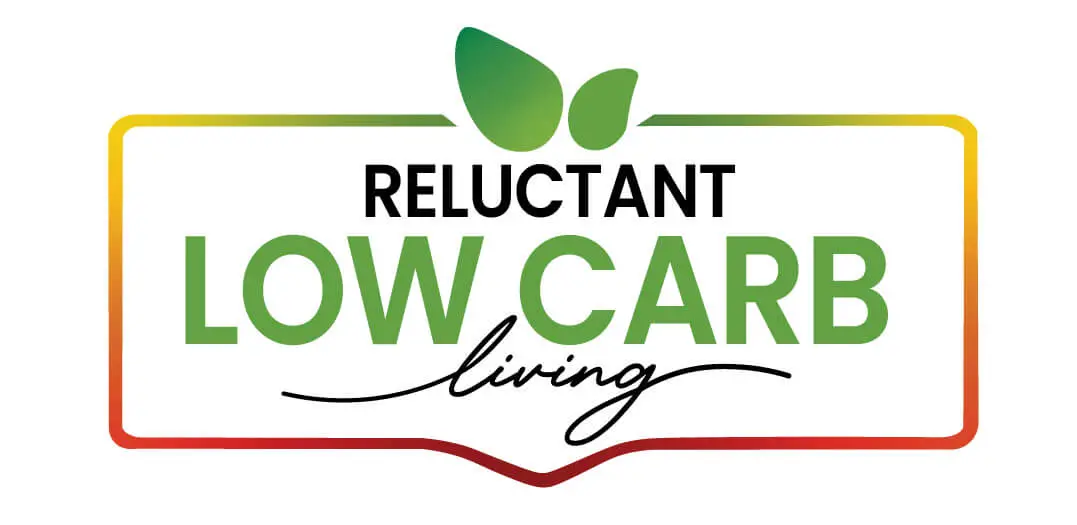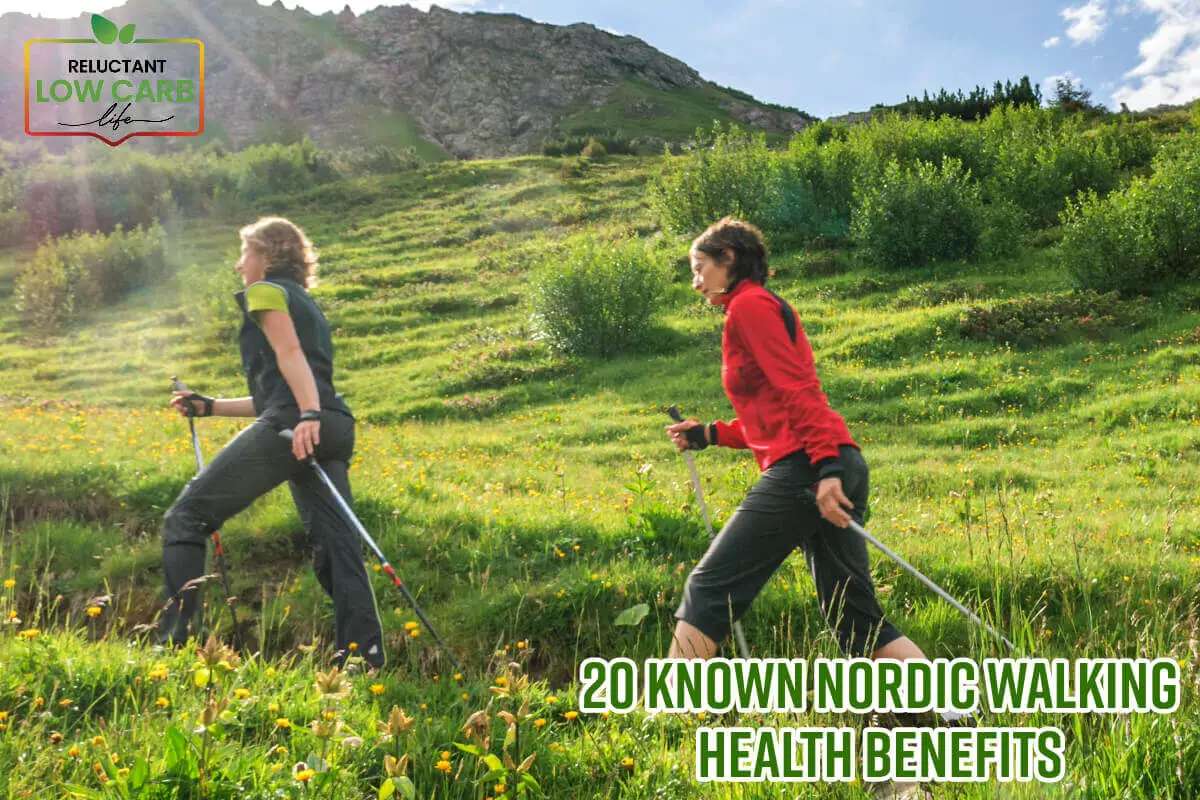I’ve been actively engaged in Nordic walking for a considerable period, and I’ve discovered a distinct preference for walking with poles. This preference is because Nordic walking offers a significantly more effective workout than traditional walking.
The advantages of Nordic walking over regular walking are numerous. Firstly, it leads to a higher calorie burn rate, providing a more intense exercise experience. Furthermore, multiple additional benefits must be explored as we delve into 20 remarkable advantages of Nordic walking.
Table of Contents
- 20 Known And Proven Nordic Walking Health Benefits
- 1. Low Impact Sport:
- 2. Total Body Workout For Upper And Lower Body:
- 3. Gentle On Joints:
- 4. Improved Posture:
- 5. Stress Management:
- 6. Calorie Burning:
- 7. Intense Workout:
- 8. Cardiovascular Health:
- 9. Brain Health:
- 10. Improved Balance:
- 11. Enhanced Strength:
- 12. Increased Endurance:
- 13. Social Interaction:
- 14. Versatility Of Nordic Walking:
- 15. Joint Mobility:
- 16. Weight Management:
- 17. Increased Lung Capacity:
- 18. Enhanced Flexibility:
- 19. Improved Sleep Quality:
- 20. Longevity And Quality of Life:
- Related Question
20 Known And Proven Nordic Walking Health Benefits
With its specialized poles and distinctive striding techniques, Nordic walking has emerged as a popular form of low-impact exercise over the years. Originating in Finland and built up the American coach Tom Rutlin’s Exerstrider technique, it allowed cross-country skiers to stay active during summer.
Since then, it has gained worldwide recognition as a fun and effective way for people of all ages to engage with nature and improve their fitness.
Read on as we delve into the numerous health benefits associated with Nordic walking.
1. Low Impact Sport:
One of the primary advantages of Nordic walking is its low-impact nature. Unlike high-impact activities like running, which can strain joints and lead to injuries, Nordic walking provides a gentle way to exercise without putting excessive stress on your body.
The specialized poles help distribute your weight, reducing the impact on your knees and hips, making it an ideal choice for individuals with joint issues or those recovering from injuries.
2. Total Body Workout For Upper And Lower Body:
Nordic walking engages all the major muscle groups in your body, providing a comprehensive workout. The coordinated use of the poles and your natural walking motion targets your upper and lower body muscles.
This results in a balanced and efficient workout to help you build strength and tone muscles.

3. Gentle On Joints:
As previously mentioned, Nordic walking is gentle on your joints, making it suitable for people of all ages and fitness levels. It reduces the risk of overuse injuries common in high-impact activities, making it an excellent option for those looking to improve their fitness without straining their joints.
4. Improved Posture:
Nordic walking promotes better posture. You must walk upright and engage your core muscles to maintain the correct technique.
This naturally aligns your spine and shoulders, helping to improve your overall posture. Over time, this can reduce back and neck pain and an enhanced sense of balance.
5. Stress Management:
Engaging in Nordic walking benefits your physical health and offers mental health advantages. Being out in nature and participating in this rhythmic activity can have a calming effect on your mind.
Combining exercise and exposure to natural surroundings can help reduce stress and boost mood.
6. Calorie Burning:
Nordic walking is a highly efficient calorie-burning activity. Research has shown that it can burn between 18 and 67 percent more calories than standard walking or light jogging.
The use of poles and the engagement of your upper body increase the intensity of the workout, leading to more significant calorie expenditure.
7. Intense Workout:
Comparatively, Nordic walking is a more intense workout than regular walking. If you were to walk the same time and distance with and without poles, you would find that Nordic walking increases the intensity of your exercise routine.
This increased intensity can lead to more substantial fitness gains in a shorter time.
8. Cardiovascular Health:
Nordic walking is an excellent exercise for cardiovascular health. The combination of brisk walking and the use of poles enhances your heart rate, promoting better circulation and cardiovascular fitness.
Regular Nordic walking can help reduce the risk of heart disease, lower blood pressure, and improve overall cardiovascular health.
9. Brain Health:
Physical exercise, including Nordic walking, is beneficial for brain health. Regular physical activity can enhance cognitive function, memory, and mood.
The combination of the physical and mental health benefits of the outdoors makes Nordic walking a holistic approach to well-being.
10. Improved Balance:
Nordic walking requires coordination between your upper and lower body and balance. This coordinated movement helps improve your overall balance and stability. Over time, this can reduce the risk of falls and injuries, especially among older individuals.
11. Enhanced Strength:
Using Nordic walking poles not only adds to the intensity of your workout but also provides resistance. This resistance helps strengthen your arm, shoulder, and chest muscles and the core and leg muscles engaged in walking.
Over time, this can improve upper body strength and overall muscular endurance.
12. Increased Endurance:
Engaging in Nordic walking regularly increases your overall endurance. As you build strength and cardiovascular fitness, you’ll find that you can walk longer distances and maintain higher energy levels throughout your walks. This enhanced endurance can positively impact your daily life, making everyday tasks less strenuous.

13. Social Interaction:
Nordic walking is often done in groups or with friends, making it a social activity. Social interaction has health benefits, including reduced loneliness and increased motivation to exercise regularly.
Being part of a supportive community of Nordic walkers can help you stay motivated and committed to your fitness goals.
14. Versatility Of Nordic Walking:
Nordic walking is a versatile activity that can be adapted to different terrains and fitness levels. Whether you prefer a leisurely walk through the park or a more challenging trek in the mountains,
Nordic walking can be tailored to suit your preferences. This adaptability makes it a sustainable long-term fitness option.
15. Joint Mobility:
In addition to being gentle on joints, Nordic walking can improve joint mobility. The rhythmic motion of walking with the poles encourages a full range of motion in your arms and shoulders. This can be especially beneficial for individuals with stiff or arthritic joints.
16. Weight Management:
Due to its calorie-burning nature, Nordic walking can be a valuable tool for weight management. Combined with a balanced diet, regular Nordic walking can help you achieve and maintain a healthy weight. It can also aid in weight loss when incorporated into a plan.
17. Increased Lung Capacity:
The aerobic nature of Nordic walking challenges your respiratory system, leading to increased lung capacity. This can improve your ability to breathe efficiently, which benefits exercise and overall health and well-being.
18. Enhanced Flexibility:
Swinging the poles and coordinating your upper and lower body movements promotes flexibility. Regular Nordic walking can increase joint flexibility, making everyday movements more accessible and reducing the risk of muscle and joint injuries.
19. Improved Sleep Quality:
Regular physical activity, such as Nordic walking, has been linked to improved sleep quality. Reduced stress, enhanced physical fitness, and exposure to natural light during outdoor walks can improve sleep patterns.

20. Longevity And Quality of Life:
Engaging in Nordic walking can positively impact your overall quality of life and may contribute to increased longevity. By improving physical, mental, and emotional well-being, Nordic walking can help you enjoy a healthier and more fulfilling life as you age.
Nordic walking is a unique and highly beneficial form of exercise that offers a wide range of health advantages. From its low-impact nature and full-body workout to its positive effects on mental health and overall well-being, Nordic walking is a versatile activity suitable for individuals of all ages and fitness levels.
Whether you want to improve your physical fitness, manage stress, or enjoy the great outdoors, Nordic walking is a beautiful option for a healthier, happier life. So, grab your poles, hit the trails, and experience the numerous benefits of Nordic walking firsthand. Your body and mind will thank you for it.
At Reluctant Low Carb Life, we are staunch advocates of the Health Trifecta: Fullness, Fitness, and Freshness. Additionally, we embrace the pillars of health, wellness, and graceful aging. Our mission is to provide honest and precise information to individuals dedicated to adopting a healthy lifestyle while enhancing their fitness and well-being.
We have a free monthly newsletter that is filled with information and helps you remain updated. Subscribe to the Reluctant Low Carb Life newsletter by clicking here.
Listen to our weekly podcast, Reluctant Low Carb Life, on all the major podcast platforms by clicking here.
Follow us on Instagram and Facebook by clicking here.
Related Question
What Happens If You Eat Too Much Cheese On Keto?
Cheese can be eaten on a keto diet but should be used as a flavoring, not the main course. If you overeat cheese, it could affect your weight loss. Some people have a hard time handling a lot of cheese. When on a Keto Diet, we recommend looking at cheese as a way to flavor your food and not as the main course for your keto meal.
You can read more about What Happens If You Eat Too Much Cheese On Keto? by clicking here.
What Are Normal Blood Sugar Levels?
Most healthcare professionals will look at several blood sugar level tests to check if your blood sugar levels are normal. The three significant tests are the A1C blood sugar level, the fasting blood sugar test, and the glucose tolerance test. All these tests have different numbers that help show if you have a normal blood sugar range.
You can read more about What Are Normal Blood Sugar Levels? by clicking here.
How Blood Sugar Levels Correlate To A1C Values
If your blood sugar levels are high, your A1C test results should also be increased. The A1C blood test is the standard test that healthcare professionals use to see if your body is prediabetic or in a state of diabetes. Because the keto and low carb lifestyle do not have sugar or carbohydrates as part of the diet, many people have found that when they are on the keto and low carb lifestyle, they see their A1C test results improve.
You can read more about How Blood Sugar Levels Correlate To A1C Values by clicking here.








